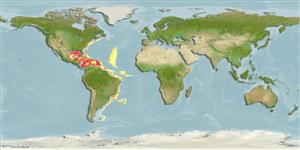>
Beryciformes (Sawbellies) >
Stephanoberycidae (Pricklefishes)
Etymology: Stephanoberyx: Greek, stephanos = crown + Greek, beryx or berys = a name of a fish, in reference to Berycidae with thin osseus ridges on the head..
More on author: Gill.
Environment: milieu / climate zone / depth range / distribution range
Ecología
marino batidemersal; rango de profundidad 945 - 4777 m (Ref. 51654). Deep-water
Western Atlantic: New England, USA to the Gulf of Mexico, Caribbean Sea, and the Lesser Antilles.
Length at first maturity / Tamaño / Peso / Age
Maturity: Lm ?, range 8 - ? cm
Max length : 8.1 cm macho / no sexado; (Ref. 37108)
Short description
Morfología | Morfometría
Espinas dorsales (total): 1; Radios blandos dorsales (total): 3. Snout not protruding beyond premaxillary symphysis (Ref. 37108).
Adults probably abyssal benthic (Ref. 51654).
Life cycle and mating behavior
Madurez | Reproducción | Puesta | Huevos | Fecundidad | Larva
Ebeling, A.W. and W.H. Weed, 1973. Order Xenoberyces (Stephanoberyciformes). In: Fishes of the Western North Atlantic. Mem. Sears Found. Mar. Res. (MSFMR), Mem. 1 (pt 6):397-478. (Ref. 31275)
IUCN Red List Status (Ref. 130435)
Threat to humans
Harmless
Human uses
Más información
Age/SizeCrecimientoLength-weightLength-lengthLength-frequenciesMorfometríaMorfologíaLarvaDinámica larvariaReclutamientoAbundanciaBRUVS
ReferenciasAcuiculturaPerfil de acuiculturaRazasGenéticaElectrophoresesheritabilidadEnfermedadesProcesamientoNutrientsMass conversion
ColaboradoresImágenesStamps, Coins Misc.SonidosCiguateraVelocidadTipo de nataciónSuperficie branquialOtolitosCerebrosVisión
Herramientas
Special reports
Download XML
Fuentes de Internet
Estimates based on models
Preferred temperature (Ref.
123201): 3.2 - 4.3, mean 4.1 °C (based on 404 cells).
Phylogenetic diversity index (Ref.
82804): PD
50 = 1.0625 [Uniqueness, from 0.5 = low to 2.0 = high].
Bayesian length-weight: a=0.01122 (0.00514 - 0.02450), b=3.04 (2.87 - 3.21), in cm total length, based on all LWR estimates for this body shape (Ref.
93245).
Nivel trófico (Ref.
69278): 3.3 ±0.5 se; based on size and trophs of closest relatives
Resiliencia (Ref.
120179): Medio, población duplicada en un tiempo mínimo de 1.4-4.4 años (Preliminary K or Fecundity.).
Fishing Vulnerability (Ref.
59153): Low vulnerability (10 of 100).
